Lyons W.C. (ed.). Standard handbook of petroleum and natural gas engineering.2001- Volume 1
Подождите немного. Документ загружается.

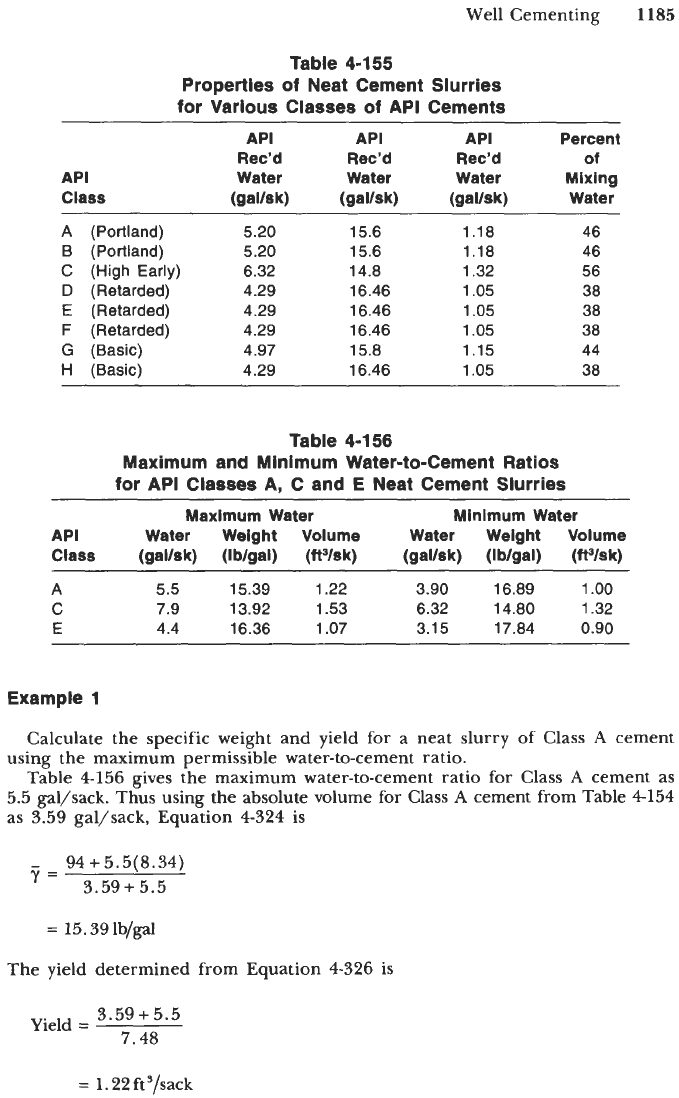
Well Cementing
1185
Table 4-155
Properties of Neat Cement Slurries
for Various Classes
of
API Cements
API API
API Percent
API Water Water
Water Mixing
Class (gallsk) (galls
k)
(gallsk) Water
Rec’d Rec’d Rec’d
of
~ ~ ~ ~~~
A
(Portland)
5.20
15.6 1.18 46
B (Portland)
5.20 15.6
1.18 46
C
(High
Early)
6.32 14.8
1.32 56
D
(Retarded)
4.29 16.46
1.05 38
E
(Retarded)
4.29 16.46
1.05 38
F
(Retarded)
4.29 16.46
1.05 38
H
(Basic)
4.29 16.46 1.05 38
G
(Basic)
4.97 15.8 1.15 44
Table 4-156
Maximum and Minimum Water-to-Cement Ratios
for API Classes A,
C
and E Neat Cement Slurries
~~~~~~~
~ ~
Maximum Water Minimum Water
API Water Weight Volume
Water Weight
Volume
Class
(gailsk)
(Iblgal) (ftVsk)
(gallsk) (Iblgal) (ft3/sk)
A
5.5
15.39
1.22
3.90 16.89
1
.oo
C
7.9 13.92 1.53
6.32
14.80 1.32
E
4.4
16.36 1.07
3.15 17.84 0.90
Example 1
Calculate the specific weight and yield for a neat slurry of Class
A
cement
using the maximum permissible water-to-cement ratio.
Table
4-156
gives the maximum water-to-cement ratio for Class
A
cement
as
5.5
gal/sack. Thus using the absolute volume for Class
A
cement from Table
4-154
as
3.59
gal/sack, Equation
4-324
is
94+ 5.5(8.34)
3.59+5.5
r=
=
15.39
Ib/@
The yield determined from Equation
4-326
is
3.59
+
5.5
7.48
Yield
=
=
1.22
ft ’/sack
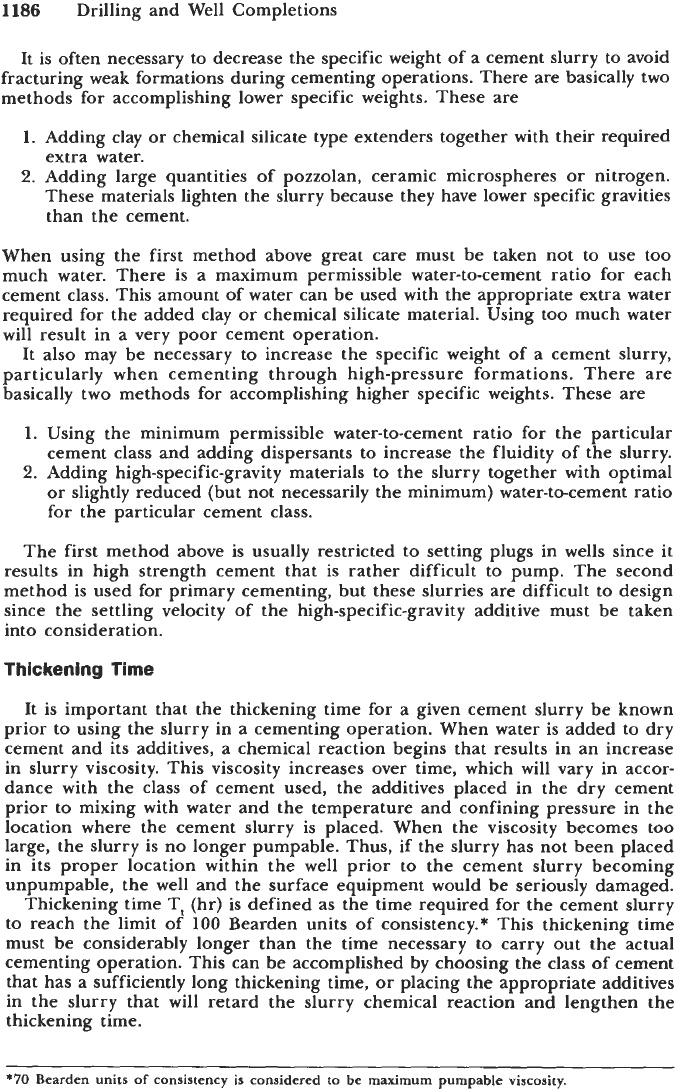
1186
Drilling and Well Completions
It is often necessary to decrease the specific weight of a cement slurry to avoid
fracturing weak formations during cementing operations. There are basically two
methods for accomplishing laver specific weights. These
are
1.
Adding clay
or
chemical silicate type extenders together with their required
extra water.
2.
Adding large quantities of pozzolan, ceramic microspheres
or
nitrogen.
These materials lighten the slurry because they have lower specific gravities
than the cement.
When using the first method above great care must be taken not to use too
much water. There is a maximum permissible water-to-cement ratio for each
cement class. This amount of water can be used with the appropriate extra water
required for the added clay
or
chemical silicate material. Using too much water
will result in
a
very poor cement operation.
It also may be necessary to increase the specific weight of a cement slurry,
particularly when cementing through high-pressure formations. There are
basically two methods for accomplishing higher specific weights. These are
1.
Using the minimum permissible water-to-cement ratio for the particular
cement class and adding dispersants to increase the fluidity of the slurry.
2.
Adding high-specific-gravity materials to the slurry together with optimal
or slightly reduced (but not necessarily the minimum) water-to-cement ratio
for the particular cement class.
The first method above
is
usually restricted to setting plugs in wells since it
results in high strength cement that is rather difficult
to
pump. The second
method is used for primary cementing, but these slurries are difficult to design
since the settling velocity of the high-specific-gravity additive must be taken
into consideration.
Thickening
Time
It is important that the thickening time for
a
given cement slurry be known
prior to using the slurry in a cementing operation. When water is added to dry
cement and its additives, a chemical reaction begins that resuIts in an increase
in slurry viscosity. This viscosity increases over time, which will vary in accor-
dance with the class
of
cement used, the additives placed in the dry cement
prior to mixing with water and the temperature and confining pressure in the
location where the cement slurry is placed. When the viscosity becomes too
large, the slurry is no longer pumpable. Thus, if the slurry has not been placed
in its proper location within the well prior to the cement slurry becoming
unpumpable, the well and the surface equipment would be seriously damaged.
Thickening time Tt (hr)
is
defined as the time required for
the
cement slurry
to reach the limit of
100
Bearden units of consistency.* This thickening time
must
be
considerably longer than the time necessary to carry out the actual
cementing operation. This can be accomplished
by
choosing the class of cement
that has
a
sufficiently long thickening time,
or
placing the appropriate additives
in the slurry that will retard the slurry chemical reaction and lengthen the
thickening time.
*70
Bearden units
of
consistency is considered
to
be
maximum
pumpable viscosity.
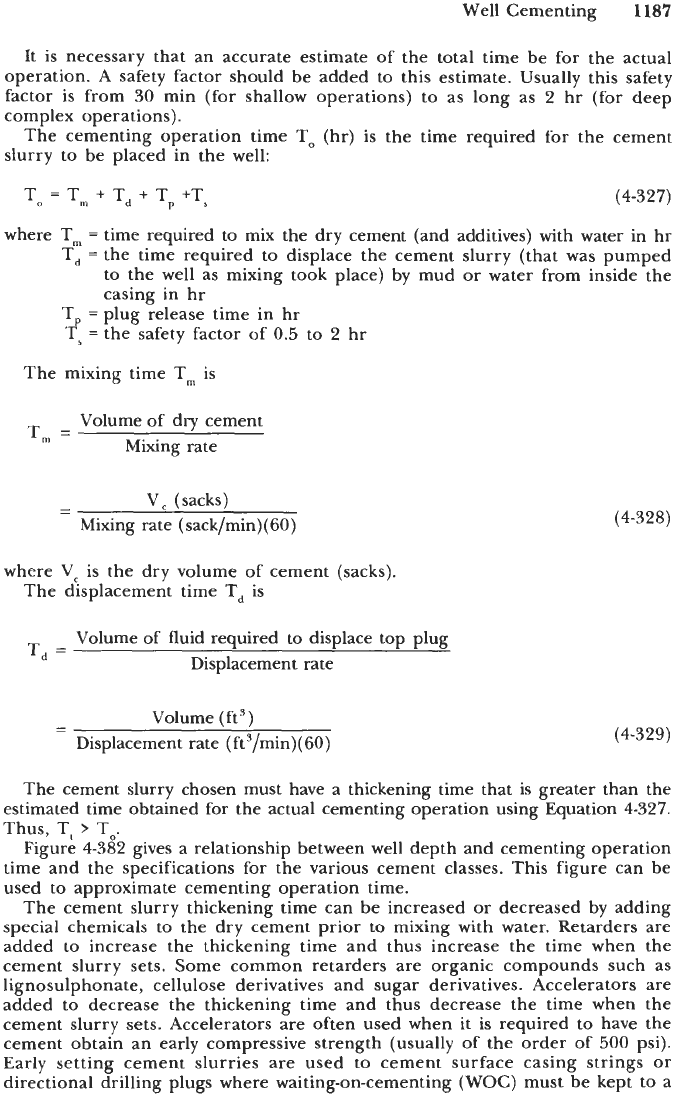
Well Cementing
1187
It is necessary that an accurate estimate of the total time be for the actual
operation. A safety factor should be added to this estimate. Usually this safety
factor is from
30
min (for shallow operations) to as long as
2
hr (for deep
complex operations).
The cementing operation time To (hr) is the time required for the cement
slurry to be placed in the well:
To
=
Tm
+
T,
+
TP
+TI
(4-327)
where
T,
=
time required to mix the dry cement (and additives) with water in hr
T,
=
the time required to displace the cement slurry (that was pumped
to the well as mixing took place) by mud
or
water from inside the
casing in hr
T,
=
plug release time in hr
Ts
=
the safety factor of
0.5
to
2
hr
The mixing time Tm is
Volume of dry cement
Mixing rate
T,
=
-
V,
(sacks)
-
Mixing rate (sack/min)( 60)
where
Vc
is the dry volume of cement (sacks).
The displacement time T, is
Volume of fluid required to displace top plug
Displacement rate
T,
=
-
Volume
(
ft
)
-
Displacement rate (ft3/min)(60)
(4-328)
(4-329)
The cement slurry chosen must have
a
thickening time that is greater than the
estimated time obtained for the actual cementing operation using Equation
4-327.
Thus,
Tt
To.
Figure
4-382
gives a relationship between well depth and cementing operation
time and the specifications for the various cement classes. This figure can be
used to approximate cementing operation time.
The cement slurry thickening time can be increased or decreased by adding
special chemicals to the dry cement prior to mixing with water. Retarders are
added to increase the thickening time and thus increase the time when the
cement slurry sets. Some common retarders are organic compounds such as
lignosulphonate, cellulose derivatives and sugar derivatives. Accelerators are
added to decrease the thickening time and thus decrease the time when the
cement slurry sets. Accelerators are often used when it is required to have the
cement obtain an early compressive strength (usually of the order of
500
psi).
Early setting cement slurries are used to cement surface casing strings or
directional drilling plugs where waiting-on-cementing (WOC) must be kept to a
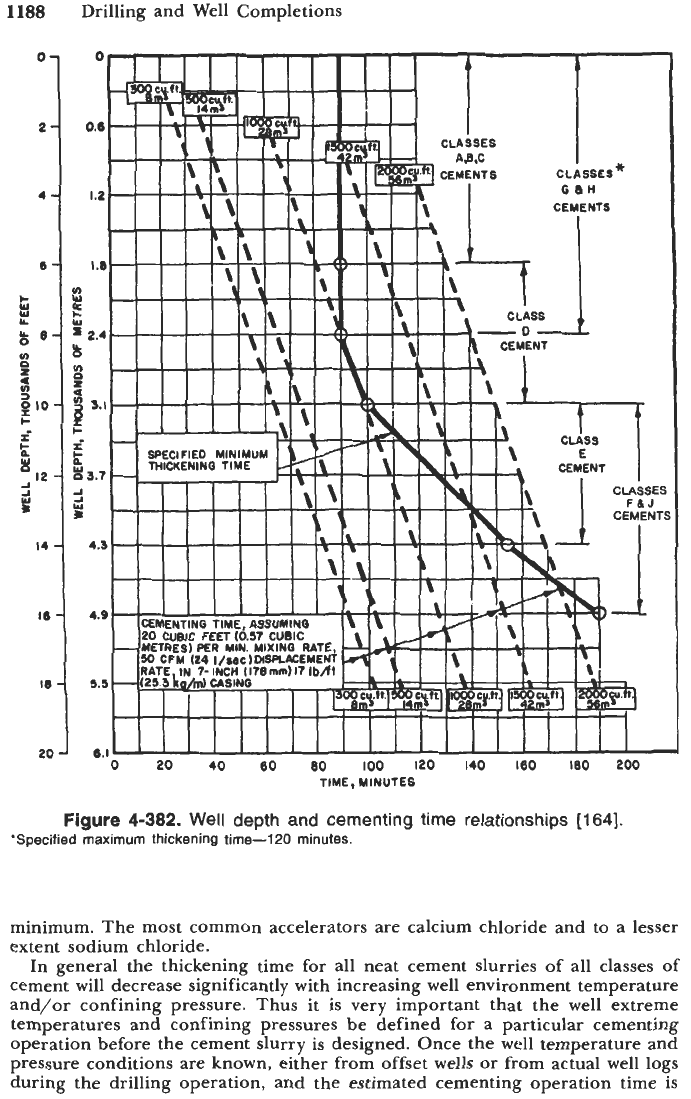
Drilling and Well Completions
Figure
4-382.
Well depth and cementing time relationships
[164].
'Specified maximum thickening time-1
20
minutes.
minimum. The most common accelerators are calcium chloride and to a lesser
extent sodium chloride.
In general the thickening time for all neat cement slurries of all classes of
cement will decrease significantly with increasing well environment temperature
and/or confining pressure. Thus it
is
very important that the well extreme
temperatures and confining pressures be defined for a particular cementing
operation before the cement slurry is designed. Once the well temperature and
pressure conditions are known, either from offset wells or from actual well logs
during the drilling operation, and the estimated cementing operation time is
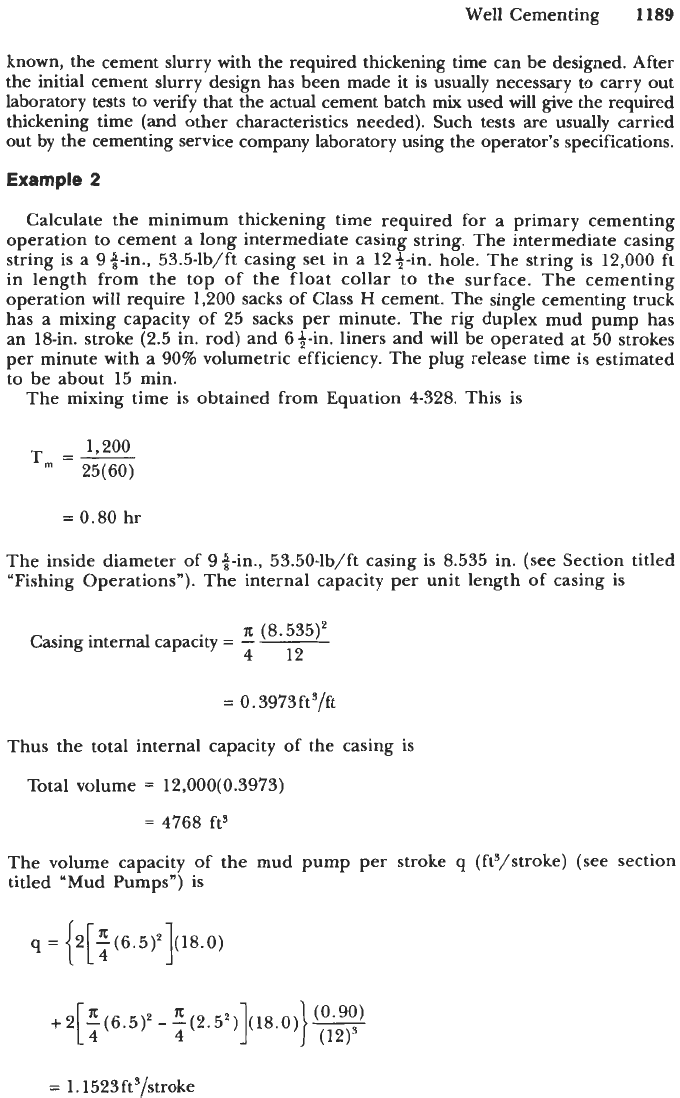
Well Cementing
1189
known, the cement slurry with the required thickening time can be designed. After
the initial cement slurry design has been made it is usually necessary to carry out
laboratory tests to verify that the actual cement batch mix used will give the required
thickening time (and other characteristics needed). Such tests are usually carried
out by the cementing service company laboratory using the operator’s specifications.
Example
2
Calculate the minimum thickening time required for a primary cementing
operation to cement a long intermediate casing string. The intermediate casing
string is a gj-in., 53.5-lb/ft casing set in a 124-in. hole. The string is 12,000
ft
in length from the top of the float collar to the surface. The cementing
operation will require
1,200
sacks of Class
H
cement. The single cementing truck
has a mixing capacity of 25 sacks per minute. The rig duplex mud pump has
an 18-in. stroke (2.5 in. rod) and 64-in. liners and will be operated at 50 strokes
per minute with a
90%
volumetric efficiency. The plug release time
is
estimated
to be about 15 min.
The mixing time is obtained from Equation 4-328. This is
1,200
T,
=-
25( 60)
=
0.80
hr
The inside diameter of gj-in., 53.5O-lb/ft casing is 8.535 in. (see Section titled
“Fishing Operations”). The internal capacity per unit length of casing is
n
(8.535)‘
Casing internal capacity
=
-
~
4 12
=
0.3973ftS/ft
Thus the total internal capacity of the casing is
Total volume
=
12,000(0.3973)
=
4768
ft3
The volume capacity of the mud pump per stroke
q
(ft3/stroke) (see section
titled “Mud Pumps”) is
q
=
2 x(6.5)’ (18.0)
H4
1
+2[f(6.5)‘--(2.5’)
n
4
=
1.
1523fta/stroke
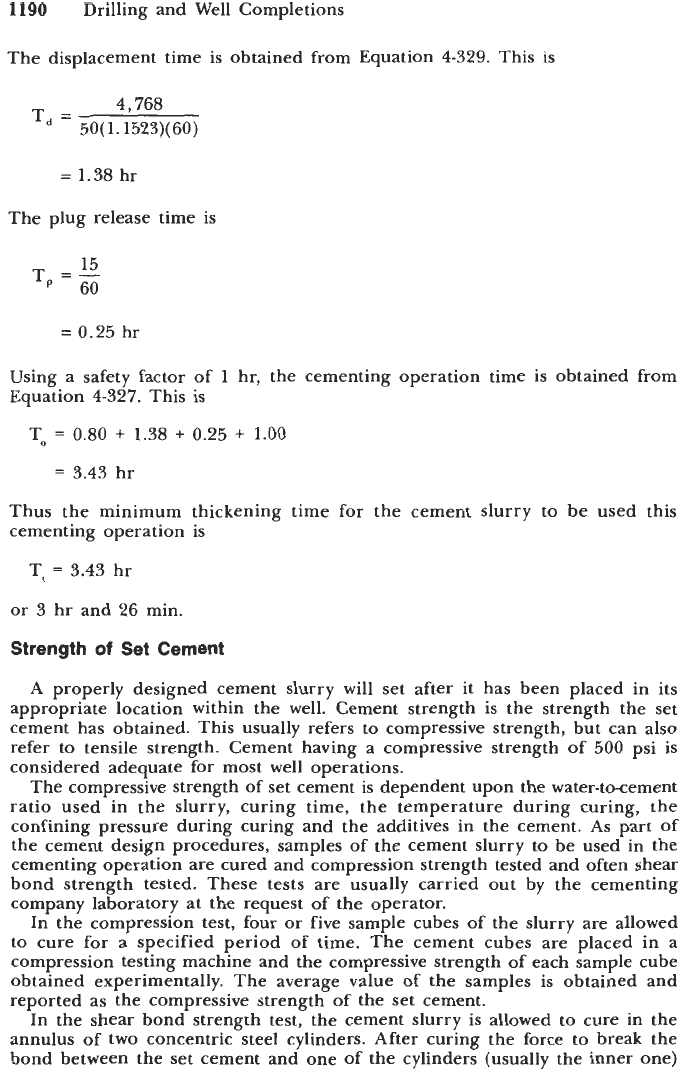
1190
Drilling and Well Completions
The displacement time is obtained from Equation
4-329.
This is
4,768
50( 1.1523)( 60)
T,
=
=
1.38
hr
The plug release time is
15
60
T,
=-
=
0.25
hr
Using a safety factor of
1
hr, the cementing operation time is obtained from
Equation
4-327.
This is
To
=
0.80
+
1.38
+
0.25
+
1.00
=
3.43
hr
Thus the minimum thickening time for the cement slurry to be used this
cementing operation is
Tt
=
3.43
hr
or
3
hr and
26
min.
Strength
of
Set Cement
A
properly designed cement slurry will set after it has been placed in its
appropriate location within the well. Cement strength is the strength the set
cement has obtained. This usually refers to compressive strength, but can also
refer to tensile strength. Cement having a compressive strength of
500
psi is
considered adequate for most well operations.
The compressive strength of set cement is dependent upon the water-tocement
ratio used in the slurry, curing time, the temperature during curing, the
confining pressure during curing and the additives in the cement.
As
part of
the cement design procedures, samples of the cement slurry to be used in the
cementing operation are cured and compression strength tested and often shear
bond strength tested. These tests are usually carried out by the cementing
company laboratory at the request of the operator.
In the compression test, four or five sample cubes of the slurry are allowed
to cure for a specified period of time. The cement cubes are placed in a
compression testing machine and the compressive strength of each sample cube
obtained experimentally. The average value of the samples is obtained and
reported as the compressive strength of the set cement.
In the shear bond strength test, the cement slurry is allowed to cure in the
annulus of two concentric steel cylinders. After curing the force to break the
bond between the set cement and one of the cylinders (usually the inner one)
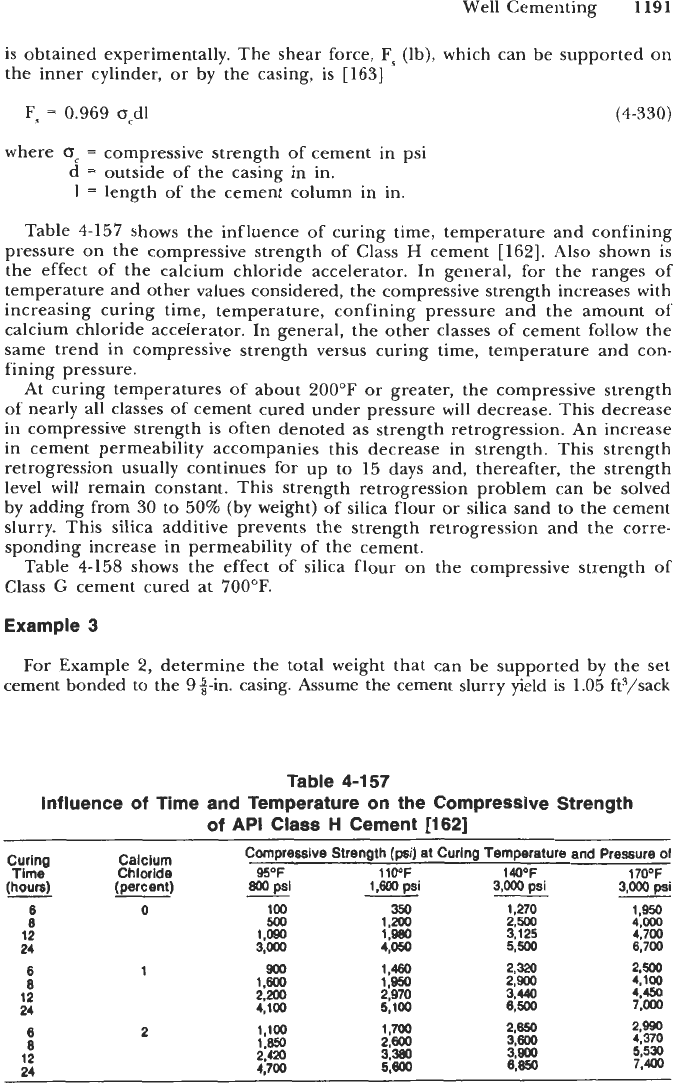
Well Cementing
1191
is obtained experimentally. The shear force, Fs (lb), which can be supported on
the inner cylinder, or by the casing, is [163]
Fs
=
0.969 ocdl (4-330)
where
oC
=
compressive strength of cement in psi
d
=
outside of the casing in in.
I
=
length of the cement column in in.
Table 4-157 shows the influence of curing time, temperature and confining
pressure on the compressive strength of Class
H
cement [162]. Also shown is
the effect of the calcium chloride accelerator. In general, for the ranges
of
temperature and other values considered, the compressive strength increases with
increasing curing time, temperature, confining pressure and the amount
of
calcium chloride accelerator. In general, the other classes of cement follow the
same trend in compressive strength versus curing time, temperature and con-
fining pressure.
At curing temperatures of about 200°F or greater, the compressive strength
of nearly all classes of cement cured under pressure will decrease. This decrease
in compressive strength is often denoted as strength retrogression. An increase
in cement permeability accompanies this decrease in strength. This strength
retrogression usually continues for up to 15 days and, thereafter, the strength
level will remain constant. This strength retrogression problem can be solved
by adding from
30
to
50%
(by weight) of silica flour or silica sand to the cement
slurry. This silica additive prevents the strength retrogression and the corre-
sponding increase in permeability of the cement.
Table 4-158 shows the effect of silica flour on the compressive strength of
Class
G
cement cured at 700°F.
Example
3
For Example 2, determine the total weight that can be supported by the set
cement bonded
to
the 9$-in. casing. Assume the cement slurry yield is 1.05 ft3/sack
Table
4-157
Influence
of
Time and Temperature on the Compressive Strength
of
API
Class
H
Cement
[162]
Compressive
Strength
(psi)
at Curing Temperature and Pressure
01
Curing Calcium
(S
(percent)
8w
psi
1,600
psi
3,000
psi
3,000
psi
Time Chloride
%OF
110OF 140°F 170'F
6
0
100
350
1,270 1.950
2,500
3.125
0
500
1,200
5,500
6,700
12
1
,m
1
24
3,000
4,050
-
2%
6
8
12
24
1
t%
4.450
7,000
?E
1,100
1700
2.850
2:600
3,600
3.-
1.850
8,850
3,380
2,420
4,700
5,800
5.530
7,400
6
2
8
12
24
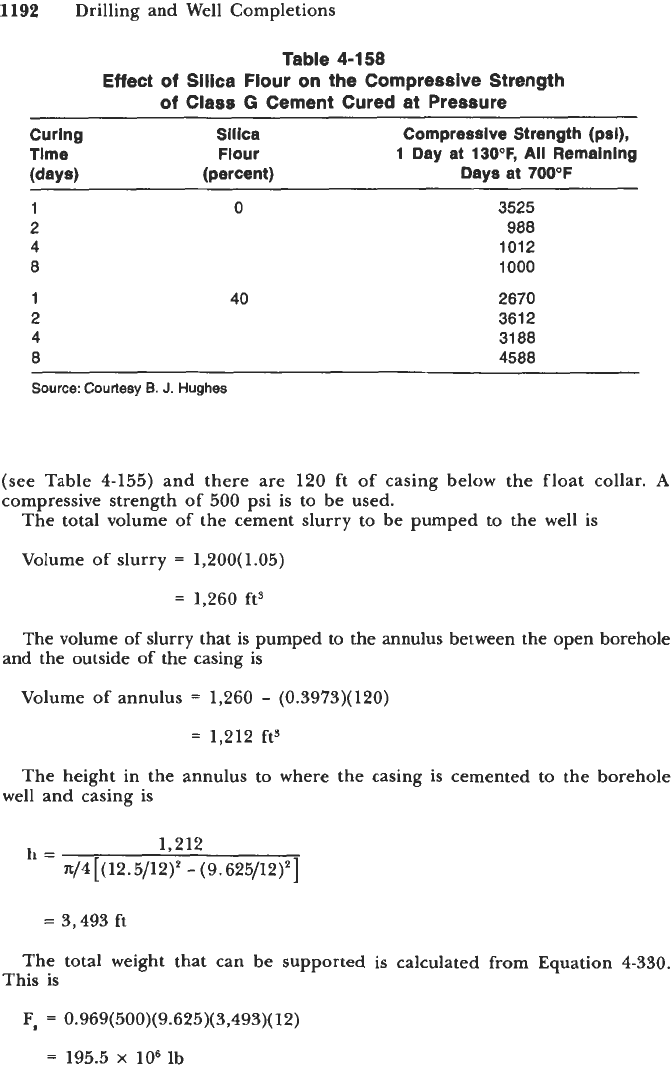
1192
Drilling and Well Completions
Table
4-158
Effect
of
Silica Flour on the Compressive Strength
of
Class
G
Cement Cured at Pressure
~~
~~
Curing Silica
Compressive Strength
(psi),
Time Flour
1
Day at 130°F,
All
Remaining
(days) (percent)
Days at 700°F
0
40
3525
988
1012
1000
2670
361
2
31 88
4588
~~~ ~ ~
Source:
Courtesy
5.
J.
Hughes
(see Table
4-155)
and there are
120
ft of casing below the float collar.
A
compressive strength of
500
psi is to be used.
The total volume
of
the cement slurry to be pumped to the well is
Volume of slurry
=
1,200(1.05)
=
1.260
fts
The volume
of
slurry that is pumped to the annulus between the open borehole
and the outside
of
the casing is
Volume of annulus
=
1,260
-
(0.3973)(120)
=
1,212
ft3
The height in the annulus to where the casing is cemented to the borehole
well and casing is
1,212
n/4 [(12.5/12)*
-
(9.625/12)*]
h=
=
3,493
ft
The total weight that can be supported is calculated
from
Equation
4-330.
This is
F,
=
0.969(500)(9.625)(3,493)(
12)
=
195.5
x
lo6
lb
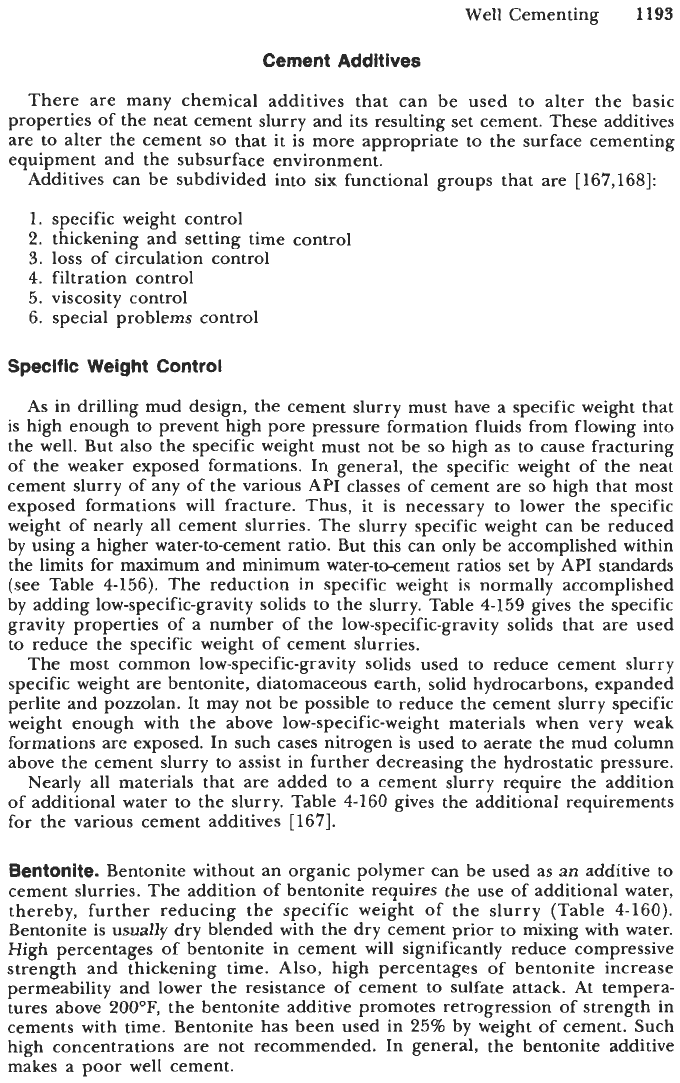
Well Cementing
1193
Cement Additives
There are many chemical additives that can be used to alter the basic
properties of the neat cement slurry and its resulting set cement. These additives
are to alter the cement
so
that it is more appropriate to the surface cementing
equipment and the subsurface environment.
Additives can be subdivided into six functional groups that are
[
167,1681:
1.
specific weight control
2.
thickening and setting time control
3.
loss of circulation control
4. filtration control
5. viscosity control
6. special problems control
Speclfic Weight Control
As in drilling mud design, the cement slurry must have a specific weight that
is high enough
to
prevent high pore pressure formation fluids from flowing into
the well. But also the specific weight must not be
so
high as to cause fracturing
of the weaker exposed formations. In general, the specific weight of the neat
cement slurry of any
of
the various API classes of cement are
so
high that most
exposed formations will fracture. Thus, it is necessary to lower the specific
weight of nearly all cement slurries. The slurry specific weight can be reduced
by using a higher water-to-cement ratio. But this can only be accomplished within
the limits for maximum and minimum water-to-cement ratios set by
API
standards
(see Table 4-156). The reduction in specific weight is normally accomplished
by adding low-specific-gravity solids to the slurry. Table 4-159 gives the specific
gravity properties of a number of the low-specific-gravity solids that are used
to reduce the specific weight of cement slurries.
The most common low-specific-gravity solids used to reduce cement slurry
specific weight are bentonite, diatomaceous earth, solid hydrocarbons, expanded
perlite and pozzolan. It may not be possible to reduce the cement slurry specific
weight enough with the above low-specific-weight materials when very weak
formations are exposed. In such cases nitrogen is used to aerate the mud column
above the cement slurry to assist in further decreasing the hydrostatic pressure.
Nearly all materials that are added to a cement slurry require the addition
of
additional water to the slurry. Table 4-160 gives the additional requirements
for the various cement additives [167].
Bentonite.
Bentonite without an organic polymer can be used as an additive to
cement slurries. The addition of bentonite requires the use of additional water,
thereby, further reducing the specific weight of the slurry (Table 4-160).
Bentonite is usually dry blended with the dry cement prior to mixing with water.
High percentages of bentonite in cement will significantly reduce compressive
strength and thickening time. Also, high percentages of bentonite increase
permeability and lower the resistance of cement to sulfate attack. At tempera-
tures above
200°F,
the bentonite additive promotes retrogression
of
strength in
cements with time. Bentonite has been used in 25% by weight of cement. Such
high concentrations are not recommended. In general, the bentonite additive
makes a poor well cement.
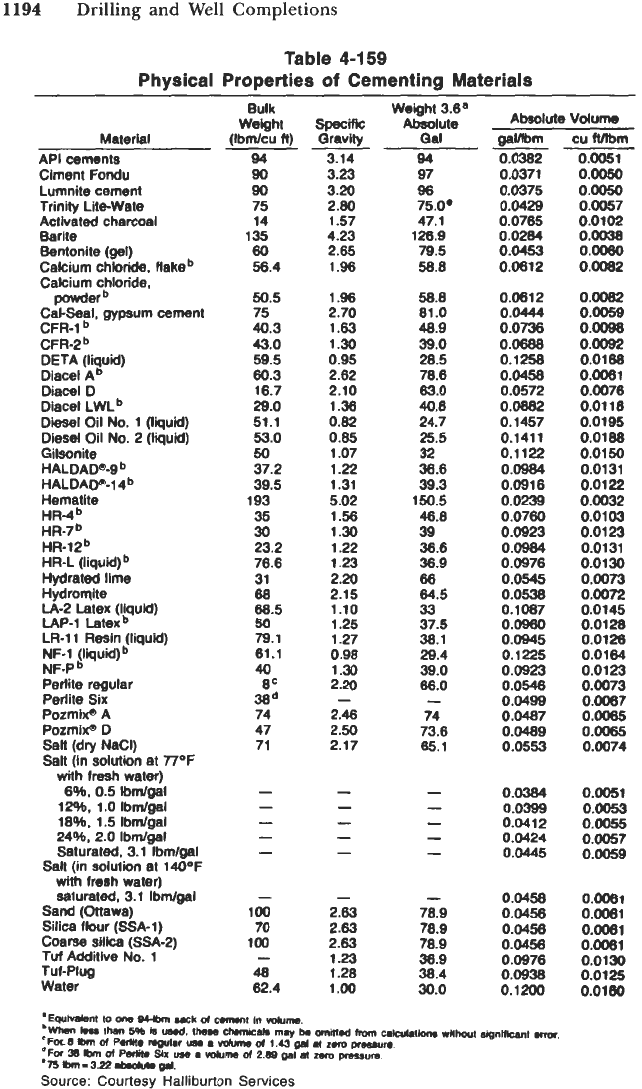
1194
Drilling
and
Well Completions
Table
4-159
Physical Properties
of
Cementing Materials
Bulk Weight 3.6'
Weiaht
SDeCi
Absolute
Absolute
volume
Material
API cements
Ciment
Fondu
Lumnite cement
Trinity Lite-Wate
Activated charcoal
Barite
Bentonite
(PI)
Calcium chloride, flakeb
Calcium chloride,
powderb
Cal-Seal. gypsum cement
DETA (liquid)
Diad
Ab
Dmcel
D
Diacel LWLb
Diesel
Oil
No.
1
(liquid)
Diesel Oil
No.
2 (liquid)
Gilsonite
CFR-I
CFR-2
HALDADQ-~~
HR-~
HALDADb"-14b
Hematite
HR-7b
HR-12b
HR-L (liquid)
Hydrated lime
Hydroqite
LA-2 Latex (!quid)
LAP-I Latex
LR-11 Resin (liquid)
NF-1
NF-P~
Perlite regular
Perlite Six
PozmixQ A
PozmixQ
D
Sall (dry NaCI)
Salt (in solution at 77*F
with lresh water)
6%.
0.5
Ibmlgal
12%. 1.0 Ibndgal
18%. 1.5 Ibmlgal
Saturated, 3.1 lbmlgal
Salt (in solution at 140OF
with fresh water)
saturated, 3.1 lbmlgal
Sand (Ottawa)
Silica
llour
(SA-1)
Coarse silica (Sa-2)
Tuf
Additive
No.
1
Water
24%, 2.0 Ibm/gal
Tul-Pl~g
(Ibnd6u
ft)
Qravily Qal
--
94
3.14
94
90
90
75
14
135
60
56.4
50.5
75
40.3
43.0
59.5
60.3
16.7
29.0
51.1
53.0
50
37.2
39.5
193
35
30
23.2
76.6
31
68
68.5
50
79.1
61.1
40
8C
306
74
47
71
-
-
-
-
-
-
100
70
100
48
62.4
-
3.23
3.20
2.80
1.57
4.23
2.65
1.96
1.96
2.70
1.63
1.30
0.95
2.62
2.10
1.36
0.82
0.85
1.07
1 .22
1.31
5.02
1.56
1.30
1.22
1.23
2.20
2.15
1.10
1.25
1.27
0.98
1.30
2.20
2.46
2.50
2.17
-
-
-
-
-
-
-
2.63
2.63
2.63
1.23
1.28
1 .00
97
96
75.0"
47.1
128.9
79.5
58.8
58.6
81
.o
48.9
39.0
28.5
78.6
63.0
40.6
24.7
25.5
32
36.6
39.3
150.5
46.8
39
36.6
36.9
66
64.5
33
37.5
30.1
29.4
39.0
66.0
74
73.6
65.1
-
-
-
-
-
-
-
78.9
78.8
78.9
36.9
30.4
30.0
geVlbm
0.0302
0.0371
0.0375
0.0429
0.0765
0.0204
0.0453
0.0612
0.0612
0.0444
0.0736
0.0688
0.1258
0.0458
0.0572
0.0882
0.1457
0.1411
0.1122
0.0984
0.0916
0.0239
0.0760
0.0923
0.0984
0.0976
0.0545
0.0538
0.1087
0.0960
0.0945
0.1225
0.0923
0.0548
0.0499
0.0487
0.0489
0.0553
0.0384
0.0399
0.0412
0.0424
0.0445
0.0458
0.0456
0.0456
0.0456
0.0976
0.0938
0.1200
cu
Mbm
0.0051
O.OO50
O.OO50
0.0057
0.0102
0.0038
O.Oo80
0.0082
O.ooo2
0.0059
0.0098
0.0092
0.016a
0.0061
0.0076
0.01 18
0.0195
0.0188
0.01
50
0.0131
0.0122
0.0032
0.0103
0.0123
0.0131
0.0130
0.0073
0.0072
0.0145
0.0120
0.0126
0.0164
0.0123
0.0073
0.0087
0.0085
0.0065
0.0074
0.0051
0.0053
0.0055
0.0057
0.0059
0.0081
0.0081
0.0081
0.0081
0.0130
0.0125
0.01go
